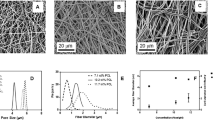Abstract
Object
Our purpose was to isolated pure, homogeneous human sperm membranes, free of cellular contaminants.
Methods
Donor semen samples collected after masturbation were stored at −70°C and eventually pooled. Each attempt at sperm membrane isolation required 800 × 106 spermatozoa which were sonicated by ultrasound (40% output; Vibra Cell). The effect of sonication time (3 × 5, 3 × 15, and 180 sec) on membrane isolation was investigated. Sonicated samples were centrifuged (500g, 5 min) and the supernatant was pipetted off. The supernatant of the centrifuged sample was layered on either a sucrose cushion (supernatant on 1.6 M sucrose) or a discontinuous sucrose gradient and centrifuged (100,000g, 1 hr). Contents of supernatants of sonicated samples and fractions (sucrose interfaces) were then fixed in 1.0% tannic acid and 2.5% buffered glutaraldehyde and examined electron microscopically using standard procedures.
Results
(1) The optimal sonification time was found to be 3 × 15 sec. (2) Membrane isolation using a sucrose cushion was found to be inadequate, showing significant cellular contamination. (3) Sperm membrane isolation from the sucrose interface between 0.75 and 1.05 M sucrose was found to be most effective.
Conclusion
The advantage of this method is its simplicity. The drawback of this method is the large number of spermatozoa required for membrane purification.
Similar content being viewed by others
References
Mack SR, Everingham J, Zaneveld LJD: Isolation and characterization of the plasma membrane from human spermatozoa. J Exp Zool 1986;240:127–136
Mack SR, Zaneveld LJD, Peterson RN, Hunt W, Russell LD: Characterization of human sperm plasma membrane: Glycolipids and polypeptides. J Exp Zool 1987;243:339–346
Young GPH, Koide SS, Goldstein M, Young JD: Isolation and partial characterization of an ion channel protein from human sperm membranes. Arch Biochem Biophys 1988;262:491–500
Hall JC, Killian GJ: Two dimensional gel electrophoretic analysis of rat sperm membrane interaction with cauda epididymal fluid. J Androl 1989;10:64–76
Mathur S, Chao L, Goust JM, Milroy GT, Woodley-Miller C, Caldwell JZ, Daru J, Williamson HO: Special antigens on sperm from autoimmume infertile men. Am J Reprod Immuno Micro 1988;17:5–13
Bearer EL, Friend DS: Morphology of mammalian sperm membranes during differentiation, maturation, and capacitation. J Electron Microsc Tech 1990;16:281–297
Mazzini MN, Ceraci P, de Cerezo JMS, Cerezo AS: Carbohydrates of the surface of the normal human spermatozoa. Am J Reprod Immuno Micro 1986;11:107–111
de Cerezo JMS, Bueno MP, Skowronsky B, Cerezo AS: Immunohistochemical localization of Con A and wheat germ lectin receptors in the normal human spermatozoa. Am J Reprod Immunol 1982;2:246–249
Tesarik J, Flechon JE: Distribution of sterols and anionic lipids in human sperm plasma membrane: Effects of in vitro capacitation. J Ultra Mol Struct Res 1986;97:227–237
Cheetham JJ, Chen RJB, Epand M: Interaction of calcium and cholesterol sulphate induces membrane destabilization and fusion: Implications for the acrosome reaction. Biochim Biophys Acta 1990;1024:367–372
Morgentaler A, Schopperle WM, Crocker RH, De Wolf WC: Protein differences between normal and oligospermic human sperm demonstrated by two-dimensional gel electrophoresis. Fertil Steril 1990;54:902–905
Tulsiani DRP, Skudlarek MD, Orgebin-Crist MC: Human sperm plasma membranes possess alpha-D-Mannosidase activity but no galactosyltransferase activity. Biol Reprod 1990;42:843–858
Suominen J, Kallajoki M, Djupsund B: Solubilization of human sperm antigens. Arch Androl 1985;15:109–116
Naaby-Hansen S: Electrophoretic map of acid and neutral human spermatozoal proteins. J Reprod Immunol 1990;17:167–185
Nikolopoulou M, Soucek DA, Vary JC: Lipid composition of the membrane released after an in vitro acrosome reaction of epididymal boar sperm. Lipids 1986;21:566–570
Berger T: Changes in exposed membrane proteins during in vitro capacitation of boar sperm. Mol Reprod Dev 1990;27:249–253
Olson GE, Hamilton DW: Characterization of the surface glycoproteins of rat spermatozoa. Biol Reprod 1978;19:26–35
Gills G, Peterson R, Russell L, Hook L, Freund M: Isolation and characterization of membrane vesicles from human an boar spermatozoa: Methods sing nitrogen cavitation and ionophore induced vesiculation. Prep Biochem 1973;8:363–378
Shabanowitz RB, O'Rand MG: Molecular changes in the human zona pellucida associated with fertilization and human sperm-zona interactions. Ann NY Acad Sci 1988;541:621–632
Reynolds ES: The use of lead citrate at high pH as an electron opaque stain in electron microscopy. J Cell Biol 1963;17:208–212
Kolk AHJ, Samuel T, Rumke P: Solubilization of a new autoantigen detected on swollen spermheads. Clin Exp Immunol 1970;227:680–685
Weil AJ: The spermatozoa-coating antigen (SCA) of the seminal vesicle. Ann NY Acad Sci 1965;124:267–273
Hekman A, Rümke P: The antigens of human seminal plasma with special reference to lactoferrin as a spermatozoa-coating antigen. Fertil Steril 1969;20:312–323
Author information
Authors and Affiliations
Rights and permissions
About this article
Cite this article
Levay, P.F., Lourens, N., Loots, G.P. et al. Electron microscopic study of human sperm membrane isolation. J Assist Reprod Genet 11, 295–302 (1994). https://doi.org/10.1007/BF02215716
Received:
Accepted:
Issue Date:
DOI: https://doi.org/10.1007/BF02215716




